1999 NISSAN PRIMERA turn signal
[x] Cancel search: turn signalPage 335 of 2267
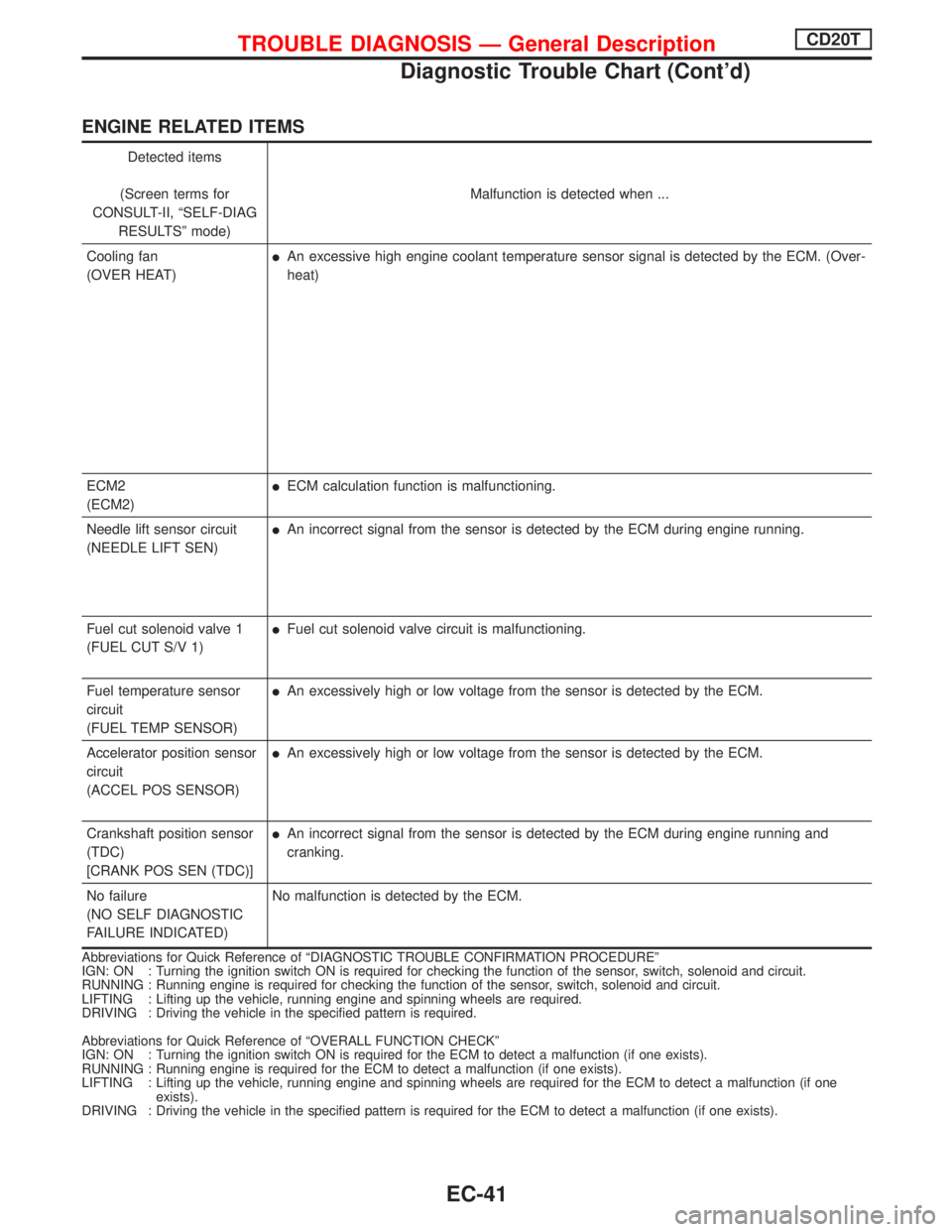
ENGINE RELATED ITEMS
Detected items
(Screen terms for
CONSULT-II, ªSELF-DIAG
RESULTSº mode)Malfunction is detected when ...
Cooling fan
(OVER HEAT)
lAn excessive high engine coolant temperature sensor signal is detected by the ECM. (Over-
heat)
ECM2
(ECM2)
lECM calculation function is malfunctioning.
Needle lift sensor circuit
(NEEDLE LIFT SEN)
lAn incorrect signal from the sensor is detected by the ECM during engine running.
Fuel cut solenoid valve 1
(FUEL CUT S/V 1)
lFuel cut solenoid valve circuit is malfunctioning.
Fuel temperature sensor
circuit
(FUEL TEMP SENSOR)
lAn excessively high or low voltage from the sensor is detected by the ECM.
Accelerator position sensor
circuit
(ACCEL POS SENSOR)
lAn excessively high or low voltage from the sensor is detected by the ECM.
Crankshaft position sensor
(TDC)
[CRANK POS SEN (TDC)]
lAn incorrect signal from the sensor is detected by the ECM during engine running and
cranking.
No failure
(NO SELF DIAGNOSTIC
FAILURE INDICATED)No malfunction is detected by the ECM.
Abbreviations for Quick Reference of ªDIAGNOSTIC TROUBLE CONFIRMATION PROCEDUREº
IGN: ON : Turning the ignition switch ON is required for checking the function of the sensor, switch, solenoid and circuit.
RUNNING : Running engine is required for checking the function of the sensor, switch, solenoid and circuit.
LIFTING : Lifting up the vehicle, running engine and spinning wheels are required.
DRIVING : Driving the vehicle in the specified pattern is required.
Abbreviations for Quick Reference of ªOVERALL FUNCTION CHECKº
IGN: ON : Turning the ignition switch ON is required for the ECM to detect a malfunction (if one exists).
RUNNING : Running engine is required for the ECM to detect a malfunction (if one exists).
LIFTING : Lifting up the vehicle, running engine and spinning wheels are required for the ECM to detect a malfunction (if one
exists).
DRIVING : Driving the vehicle in the specified pattern is required for the ECM to detect a malfunction (if one exists).
TROUBLE DIAGNOSIS Ð General DescriptionCD20T
Diagnostic Trouble Chart (Cont'd)
EC-41
Page 337 of 2267
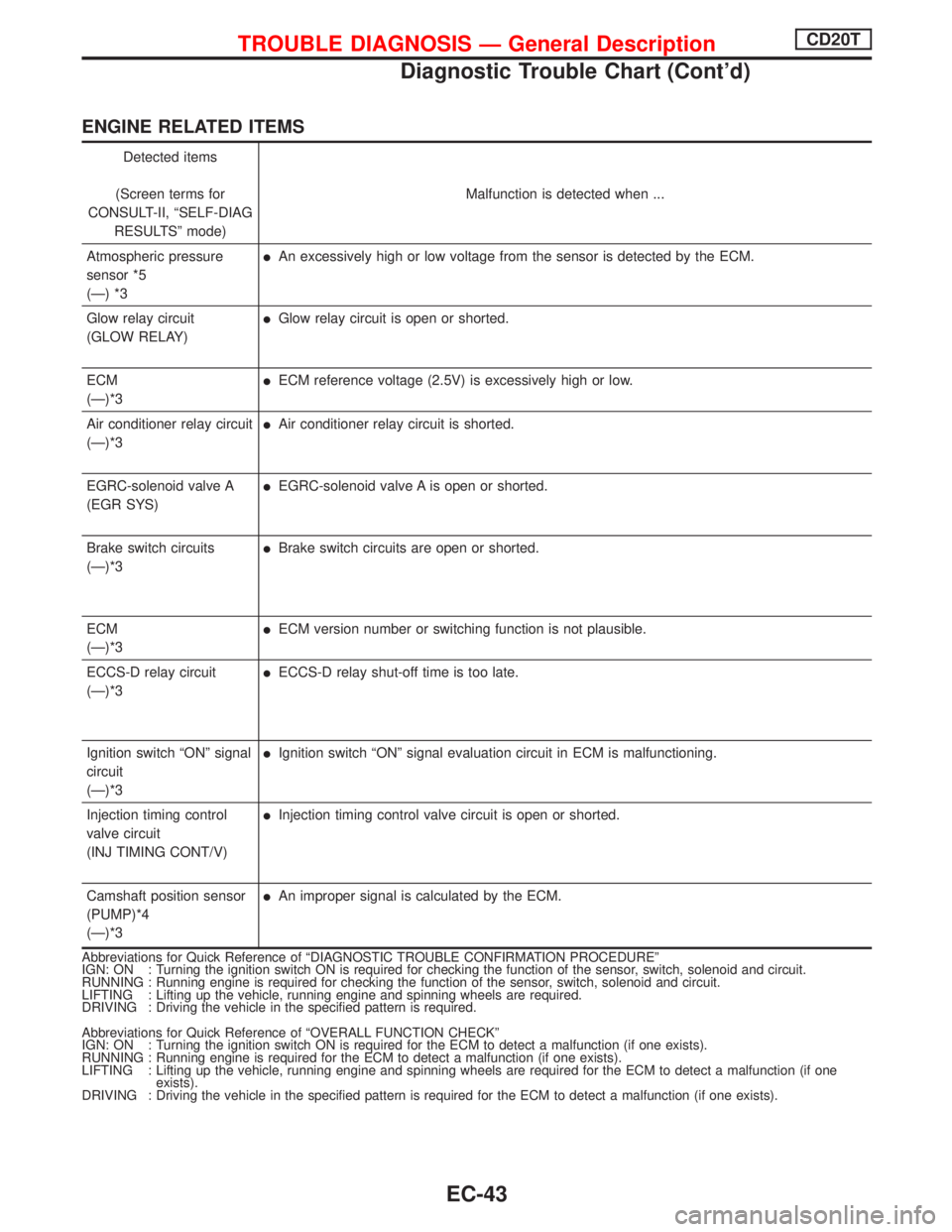
ENGINE RELATED ITEMS
Detected items
(Screen terms for
CONSULT-II, ªSELF-DIAG
RESULTSº mode)Malfunction is detected when ...
Atmospheric pressure
sensor *5
(Ð) *3
lAn excessively high or low voltage from the sensor is detected by the ECM.
Glow relay circuit
(GLOW RELAY)
lGlow relay circuit is open or shorted.
ECM
(Ð)*3
lECM reference voltage (2.5V) is excessively high or low.
Air conditioner relay circuit
(Ð)*3
lAir conditioner relay circuit is shorted.
EGRC-solenoid valve A
(EGR SYS)
lEGRC-solenoid valve A is open or shorted.
Brake switch circuits
(Ð)*3
lBrake switch circuits are open or shorted.
ECM
(Ð)*3
lECM version number or switching function is not plausible.
ECCS-D relay circuit
(Ð)*3
lECCS-D relay shut-off time is too late.
Ignition switch ªONº signal
circuit
(Ð)*3
lIgnition switch ªONº signal evaluation circuit in ECM is malfunctioning.
Injection timing control
valve circuit
(INJ TIMING CONT/V)
lInjection timing control valve circuit is open or shorted.
Camshaft position sensor
(PUMP)*4
(Ð)*3
lAn improper signal is calculated by the ECM.
Abbreviations for Quick Reference of ªDIAGNOSTIC TROUBLE CONFIRMATION PROCEDUREº
IGN: ON : Turning the ignition switch ON is required for checking the function of the sensor, switch, solenoid and circuit.
RUNNING : Running engine is required for checking the function of the sensor, switch, solenoid and circuit.
LIFTING : Lifting up the vehicle, running engine and spinning wheels are required.
DRIVING : Driving the vehicle in the specified pattern is required.
Abbreviations for Quick Reference of ªOVERALL FUNCTION CHECKº
IGN: ON : Turning the ignition switch ON is required for the ECM to detect a malfunction (if one exists).
RUNNING : Running engine is required for the ECM to detect a malfunction (if one exists).
LIFTING : Lifting up the vehicle, running engine and spinning wheels are required for the ECM to detect a malfunction (if one
exists).
DRIVING : Driving the vehicle in the specified pattern is required for the ECM to detect a malfunction (if one exists).
TROUBLE DIAGNOSIS Ð General DescriptionCD20T
Diagnostic Trouble Chart (Cont'd)
EC-43
Page 343 of 2267
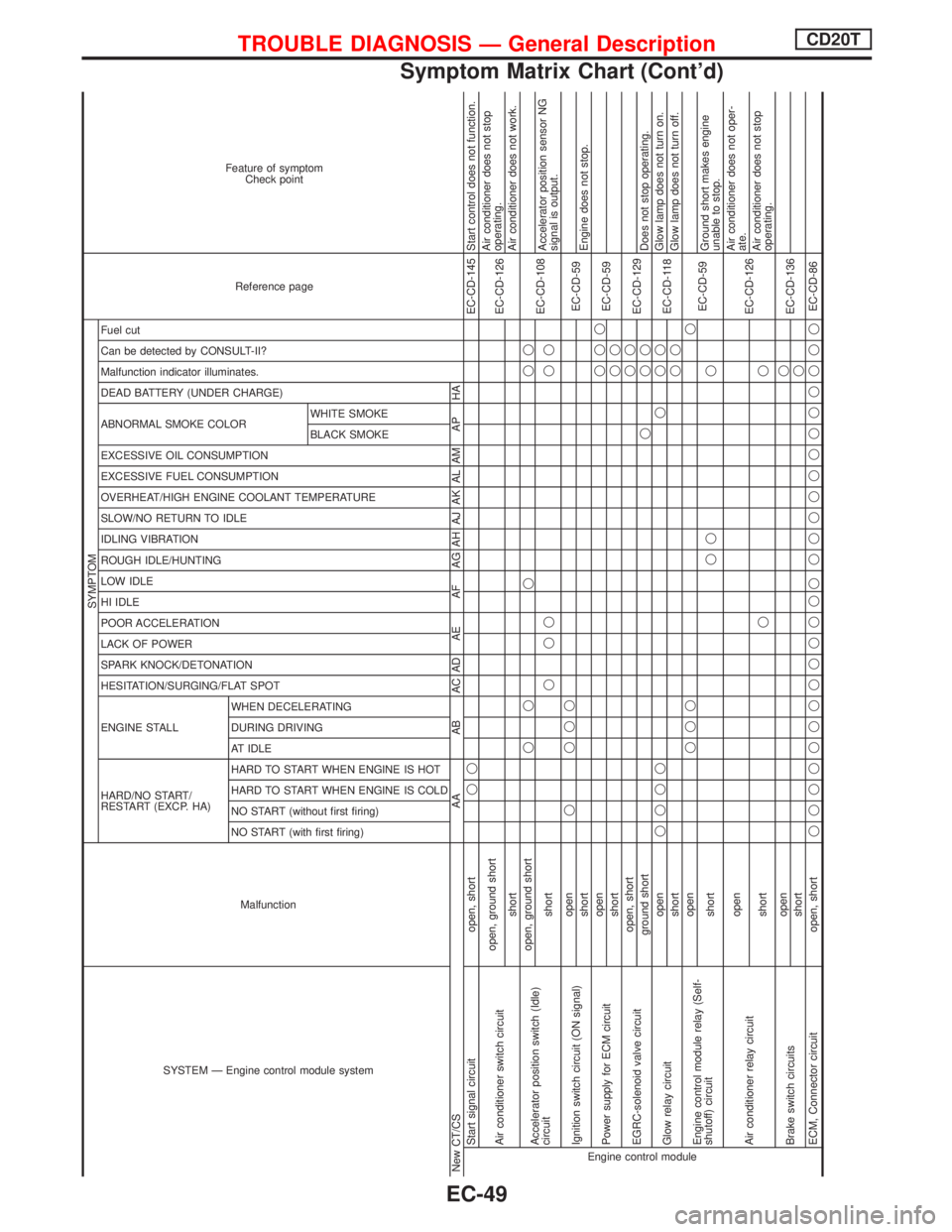
SYSTEM Ð Engine control module systemMalfunction
SYMPTOM
Reference page Feature of symptom
Check point
HARD/NO START/
RESTART (EXCP. HA) ENGINE STALL HESITATION/SURGING/FLAT SPOT SPARK KNOCK/DETONATION
LACK OF POWER
POOR ACCELERATION
HI IDLE
LOW IDLE
ROUGH IDLE/HUNTING
IDLING VIBRATION
SLOW/NO RETURN TO IDLE
OVERHEAT/HIGH ENGINE COOLANT TEMPERATURE
EXCESSIVE FUEL CONSUMPTION
EXCESSIVE OIL CONSUMPTION ABNORMAL SMOKE COLOR
DEAD BATTERY (UNDER CHARGE) Malfunction indicator illuminates.
Can be detected by CONSULT-II?
Fuel cut
NO START (with first firing) NO START (without first firing)
HARD TO START WHEN ENGINE IS COLD
HARD TO START WHEN ENGINE IS HOT
AT IDLE
DURING DRIVING
WHEN DECELERATINGBLACK SMOKE WHITE SMOKE
New CT/CS AA AB AC AD AE AF AG AH AJ AK AL AM AP HAEngine control moduleStart signal circuit open, shortqqEC-CD-145 Start control does not function.
Air conditioner switch circuitopen, ground short
EC-CD-126Air conditioner does not stop
operating.
shortAir conditioner does not work.
Accelerator position switch (Idle)
circuitopen, ground shortqq q qq
EC-CD-108
shortqqq qqAccelerator position sensor NG
signal is output.
Ignition switch circuit (ON signal)openq qqq
EC-CD-59
shortEngine does not stop.
Power supply for ECM circuitopenqqq
EC-CD-59
shortqq
EGRC-solenoid valve circuitopen, shortqq
EC-CD-129
ground shortqqqDoes not stop operating.
Glow relay circuitopenqqqq q qq
EC-CD-118Glow lamp does not turn on.
shortqqGlow lamp does not turn off.
Engine control module relay (Self-
shutoff) circuitopenqqqq
EC-CD-59
shortqq qGround short makes engine
unable to stop.
Air conditioner relay circuitopen
EC-CD-126Air conditioner does not oper-
ate.
shortqqAir conditioner does not stop
operating.
Brake switch circuitsopenq
EC-CD-136
shortq
ECM, Connector circuit open, shortqqqqqqqqqqqqq qqqqqqqqqqqqEC-CD-86
TROUBLE DIAGNOSIS Ð General DescriptionCD20T
Symptom Matrix Chart (Cont'd)
EC-49
Page 344 of 2267

CONSULT-II Reference Value in Data Monitor
Mode
Remarks:lSpecification data are reference values.lSpecification data are output/input values which are detected or supplied by the ECM at the connector.
* Specification data may not be directly related to their components signals/values/operations.
MONITOR ITEM CONDITION SPECIFICATION
CKPS×RPM (TDC)
lTachometer: ConnectlRun engine and compare tachometer indication with the CONSULT-II value.Almost the same speed as the CON-
SULT-II value.
CKPS×RPM-PUMP
COOLAN TEMP/S
lEngine: After warming up More than 70ÉC (158ÉF)
VHCL SPEED SE
lTurn drive wheels and compare speedometer indication with the CON-
SULT-II valueAlmost the same speed as
the CONSULT-II value
FUEL TEMP SEN
lEngine: After warming up More than 40ÉC (104 ÉF)
ACCEL POS SEN
lIgnition switch: ON
(Engine stopped)Accelerator pedal: release Approx. 0.40V
Accelerator pedal: depress Approx. 3.3V
OFF ACCEL POS
lIgnition switch: ON
(Engine stopped)Accelerator pedal: release ON
Accelerator pedal: slightly open OFF
C/SLEEV POS/S
lEngine: After warming up Approx. 2.5V
BATTERY VOLT
lIgnition switch: ON (Engine stopped) 11 - 14V
START SIGNAL
lIgnition switch: ON,START,ON OFF,ON,OFF
AIR COND SIG
lEngine: After warming up, idle the
engineAir conditioner switch: ªOFFº OFF
Air conditioner switch: ªONº
(Compressor operates.)ON
IGN SW
lIgnition switch: ON,OFF ON,OFF
MAS AIR/FL SE
lEngine: After warming uplAir conditioner switch: ªOFFºlShift lever: ªNºlNo-loadIdle 0.8 - 2.7V
2,000 rpm 2.2 - 2.8V
ACT INJ TIMG
lEngine: After warming uplAir conditioner switch: ªOFFºlShift lever: ªNºlNo-loadlAt sea levelIdle -0.5 to -1.5É
2,000 rpm +2.5É to +3.5É
TARGET F/INJ
lEngine: After warming uplAir conditioner switch: ªOFFºlShift lever: ªNºlNo-loadlAt sea levelIdle 8.0 - 8.8 mm
3/stroke
2,000 rpm Approx. 7.6 mm
3/stroke
BRAKE SW
lIgnition switch: ONBrake pedal: released OFF
Brake pedal: depressed ON
BRAKE SW 2
lIgnition switch: ONBrake pedal: released OFF
Brake pedal: depressed ON
FUEL CUT S/V
lIgnition switch: ON,OFF ON,OFF
AIR COND RLY
lAir conditioner switch: OFF,ON OFF,ON
GLOW RLY
lRefer to EC-CD-124.
COOLING FAN
lWhen cooling fan is stopped. OFF
lWhen cooling fan operates at low speed. LOW
lWhen cooling fan operates at high speed. HI
EGRC SOL/V A
lEngine: After warming uplAir conditioner switch: ªOFFºlShift lever: ªNºlNo-loadlAt sea levelIdle OFF
2,800 rpm ON
TROUBLE DIAGNOSIS Ð General DescriptionCD20T
EC-50
Page 349 of 2267
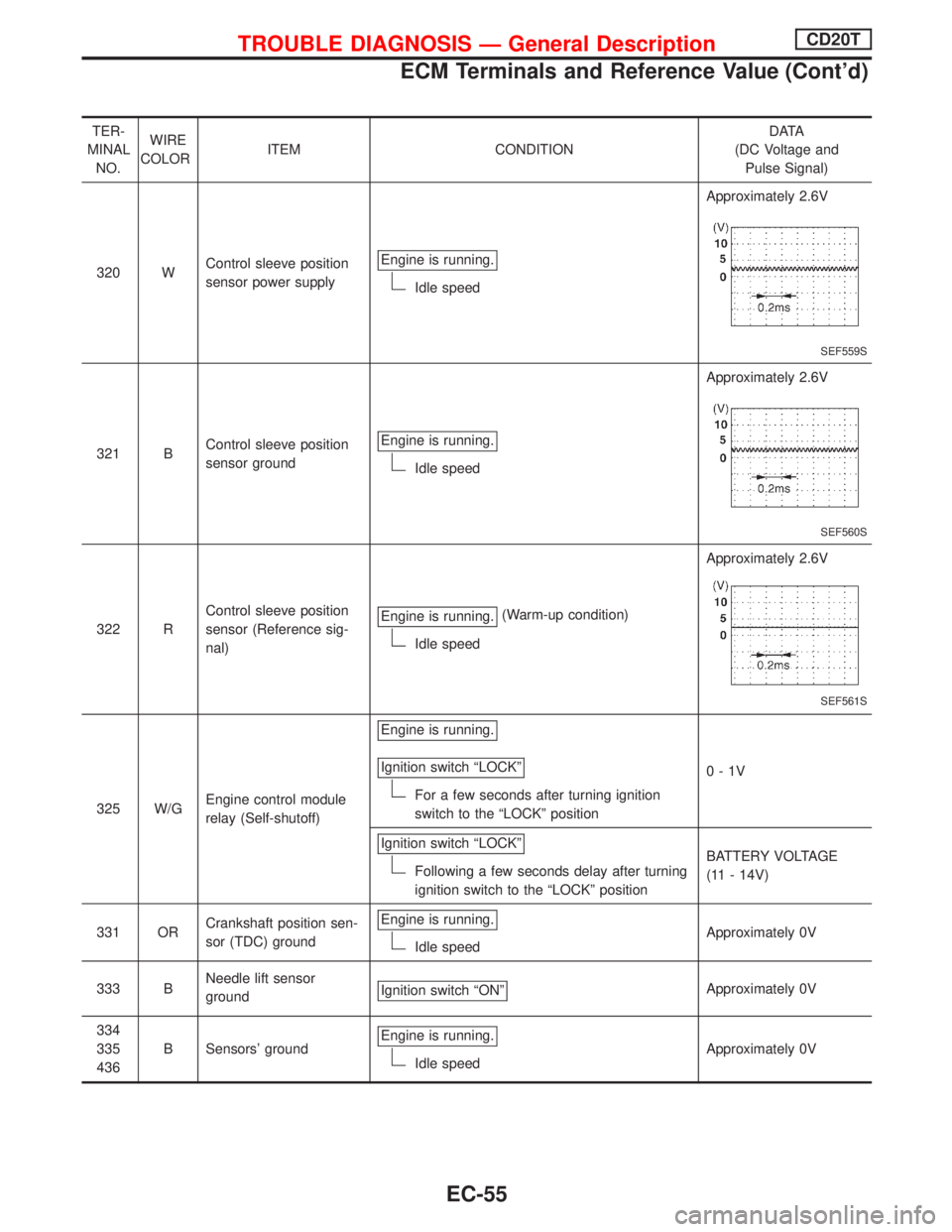
TER-
MINAL
NO.WIRE
COLORITEM CONDITIOND ATA
(DC Voltage and
Pulse Signal)
320 WControl sleeve position
sensor power supplyEngine is running.
Idle speedApproximately 2.6V
SEF559S
321 BControl sleeve position
sensor groundEngine is running.Idle speedApproximately 2.6V
SEF560S
322 RControl sleeve position
sensor (Reference sig-
nal)Engine is running.(Warm-up condition)
Idle speedApproximately 2.6V
SEF561S
325 W/GEngine control module
relay (Self-shutoff)Engine is running.
Ignition switch ªLOCKº
For a few seconds after turning ignition
switch to the ªLOCKº position0-1V
Ignition switch ªLOCKº
Following a few seconds delay after turning
ignition switch to the ªLOCKº positionBATTERY VOLTAGE
(11 - 14V)
331 ORCrankshaft position sen-
sor (TDC) groundEngine is running.
Idle speedApproximately 0V
333 BNeedle lift sensor
groundIgnition switch ªONº
Approximately 0V
334
335
436B Sensors' groundEngine is running.
Idle speedApproximately 0V
TROUBLE DIAGNOSIS Ð General DescriptionCD20T
ECM Terminals and Reference Value (Cont'd)
EC-55
Page 351 of 2267
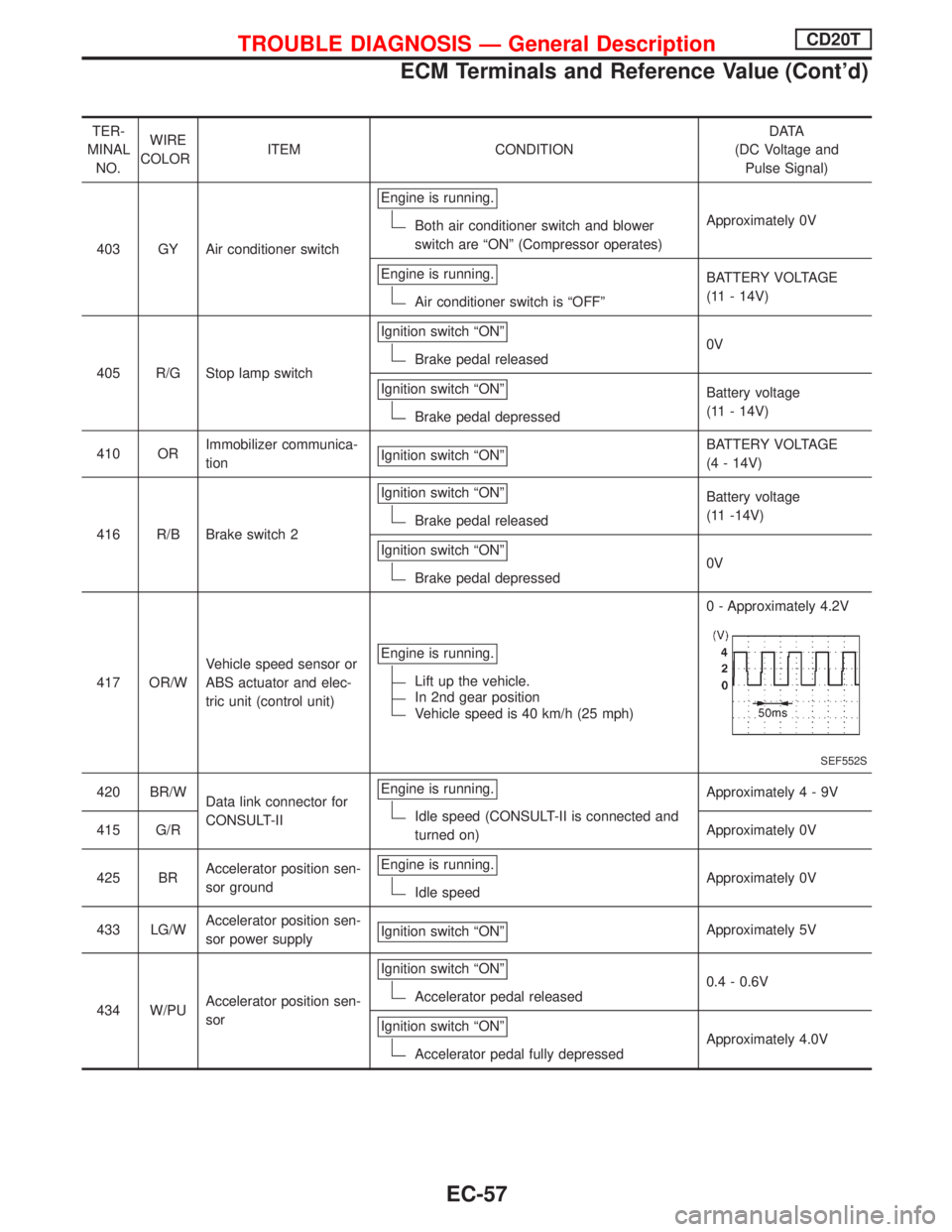
TER-
MINAL
NO.WIRE
COLORITEM CONDITIOND ATA
(DC Voltage and
Pulse Signal)
403 GY Air conditioner switchEngine is running.
Both air conditioner switch and blower
switch are ªONº (Compressor operates)Approximately 0V
Engine is running.
Air conditioner switch is ªOFFºBATTERY VOLTAGE
(11 - 14V)
405 R/G Stop lamp switchIgnition switch ªONº
Brake pedal released0V
Ignition switch ªONº
Brake pedal depressedBattery voltage
(11 - 14V)
410 ORImmobilizer communica-
tionIgnition switch ªONº
BATTERY VOLTAGE
(4 - 14V)
416 R/B Brake switch 2Ignition switch ªONº
Brake pedal releasedBattery voltage
(11 -14V)
Ignition switch ªONº
Brake pedal depressed0V
417 OR/WVehicle speed sensor or
ABS actuator and elec-
tric unit (control unit)Engine is running.
Lift up the vehicle.
In 2nd gear position
Vehicle speed is 40 km/h (25 mph)0 - Approximately 4.2V
SEF552S
420 BR/W
Data link connector for
CONSULT-IIEngine is running.
Idle speed (CONSULT-II is connected and
turned on)Approximately4-9V
415 G/RApproximately 0V
425 BRAccelerator position sen-
sor groundEngine is running.
Idle speedApproximately 0V
433 LG/WAccelerator position sen-
sor power supplyIgnition switch ªONº
Approximately 5V
434 W/PUAccelerator position sen-
sorIgnition switch ªONº
Accelerator pedal released0.4 - 0.6V
Ignition switch ªONº
Accelerator pedal fully depressedApproximately 4.0V
TROUBLE DIAGNOSIS Ð General DescriptionCD20T
ECM Terminals and Reference Value (Cont'd)
EC-57
Page 355 of 2267

pA
CHECK VOLTAGE BETWEEN ENGINE
CONTROL MODULE RELAY AND
GROUND.
Check voltage between ECM relay connec-
tor terminals
p2,p3and ground with
CONSULT-II or tester.
Voltage: Battery voltage
OK
ENG
Check the following:
l15A fuselHarness for open or
short-circuit between
ECM relay and battery.
If NG, replace fuse or repair
harness or connectors.
CHECK OUTPUT SIGNAL CIRCUIT.
Check harness continuity between ECM
connector terminal
325and ECM relay
connector terminal
p1.
Continuity should exist.
If OK, check harness for short-circuit.
OK
ENGlCheck harness connec-
torsE43,F2
Repair harness or connec-
tors.
CHECK ECM RELAY.
1. Apply 12V direct current between ECM
relay connector terminals
p1andp2.
2. Check continuity between engine control
module relay connector terminals
p3and
p5.
12V (
p1-p2) applied:
Continuity exists.
No voltage applied:
No continuity
OK
ENG
Replace ECM relay.
CHECK GROUND CIRCUIT.
1. Turn ignition switch to ªLOCKº position.
2. Check harness continuity between ECM
connector terminals
104,105,106
and engine ground.
Continuity should exist.
If resistance is too high, loosen, clean and
retighten engine ground.
If OK, check harness for short-circuit.
OK
ENG
Repair harness or connec-
tors.
Check ECM pin terminals for damage and
check the connection of ECM harness con-
nector.
INSPECTION END
YEC352 ECM relay
connector
NEF189A ECM relay
connector
YEC354 ECM relay
connector
NEF190A
NEF399 Engine ground
H
H
H
H
H
H
TROUBLE DIAGNOSIS FOR POWER SUPPLYCD20T
Main Power Supply and Ground Circuit
(Cont'd)
EC-61
Page 358 of 2267
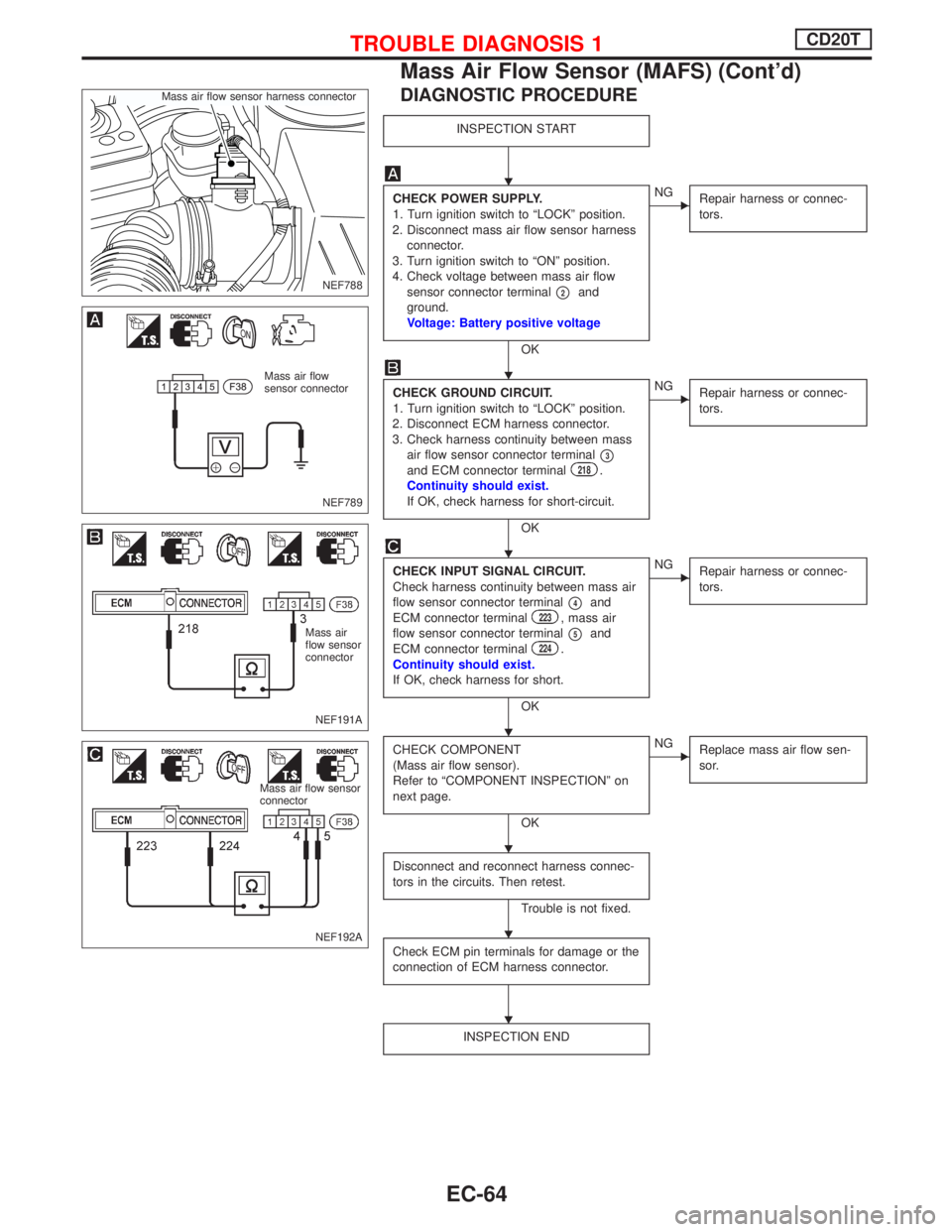
DIAGNOSTIC PROCEDURE
INSPECTION START
CHECK POWER SUPPLY.
1. Turn ignition switch to ªLOCKº position.
2. Disconnect mass air flow sensor harness
connector.
3. Turn ignition switch to ªONº position.
4. Check voltage between mass air flow
sensor connector terminal
p2and
ground.
Voltage: Battery positive voltage
OK
ENG
Repair harness or connec-
tors.
CHECK GROUND CIRCUIT.
1. Turn ignition switch to ªLOCKº position.
2. Disconnect ECM harness connector.
3. Check harness continuity between mass
air flow sensor connector terminal
p3and ECM connector terminal218.
Continuity should exist.
If OK, check harness for short-circuit.
OK
ENG
Repair harness or connec-
tors.
CHECK INPUT SIGNAL CIRCUIT.
Check harness continuity between mass air
flow sensor connector terminal
p4and
ECM connector terminal223, mass air
flow sensor connector terminal
p5and
ECM connector terminal224.
Continuity should exist.
If OK, check harness for short.
OK
ENG
Repair harness or connec-
tors.
CHECK COMPONENT
(Mass air flow sensor).
Refer to ªCOMPONENT INSPECTIONº on
next page.
OK
ENG
Replace mass air flow sen-
sor.
Disconnect and reconnect harness connec-
tors in the circuits. Then retest.
Trouble is not fixed.
Check ECM pin terminals for damage or the
connection of ECM harness connector.
INSPECTION END
NEF788 Mass air flow sensor harness connector
NEF789
Mass air flow
sensor connector
NEF191A
Mass air
flow sensor
connector
NEF192A
Mass air flow sensor
connector
H
H
H
H
H
H
H
TROUBLE DIAGNOSIS 1CD20T
Mass Air Flow Sensor (MAFS) (Cont'd)
EC-64